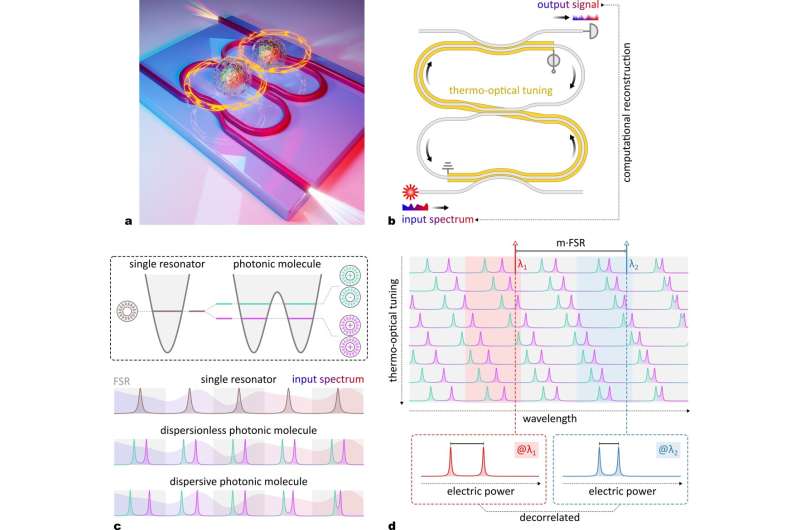This article has been reviewed according to Science X's editorial process and policies. Editors have highlighted the following attributes while ensuring the content's credibility:
fact-checked
peer-reviewed publication
trusted source
proofread
Chip-scale spectrometry using a photonic molecule

Chip-scale miniaturization of spectrometers allows rapid detection of spectral information in portable devices, opening up new applications. However, integrated spectrometers typically suffer from a trade-off between spectral resolution and optical bandwidth.
To solve this problem, scientists from Hong Kong developed a new type of spectrometer using dispersion-engineered coupled resonators, which resemble a two-level molecule. Different free-spectral ranges are identified from the dispersive mode splitting, leading to spectrum reconstruction with ultrahigh resolution over an ultrabroad bandwidth.
The optical spectrometer plays an indispensable role in many scientific and industrial applications, such as material analysis, biological sensing, optical tomography and hyperspectral imaging. Conventional benchtop spectrometers are susceptible to mechanical vibrations and are ill-suited for field deployment outside the laboratory.
Integrated spectrometers, which are built with all-solid-state photonic integrated circuits, have advantages of small size, robustness to vibrations, and potentially low cost. Nevertheless, most of the reported integrated spectrometers suffer from an inherent trad-off between spectral resolution and operation bandwidth. High spectral resolution requires long optical path length to support sufficient spectral decorrelation, which results in a smaller free-spectral range (FSR).
In a new paper published in Light: Science & Applications, a team of scientists, led by Professor Hon Ki Tsang from the Department of Electronic Engineering, the Chinese University of Hong Kong, have developed a ground-breaking method that overcomes the resolution-bandwidth limit in chip-scale spectrometry.
The proposed scheme is based on a pair of identical tunable micro-ring resonators (MRR), in which the strong inter-cavity coupling splits each resonant mode into a symmetric mode and an anti-symmetric mode. This unique behavior resembles the energy-level splitting in a two-level molecule that consists of two atoms. Interestingly, the mode-splitting strength is proportional to the coupling strength.
As such, by engineering the dispersion of the "photonic molecule", the splitting strength will vary throughout the whole bandwidth containing multiple FSRs. When simultaneously tuning two MRRs, each wavelength channel will produce a distinct scanning trace, making it possible to reconstruct any unknown input spectrum.
In the experiment, numerous test spectra with diverse complex features are retrieved using the photonic-molecule scheme. The demonstrated spectral resolution is 40 pm throughout a bandwidth of 100 nm. Remarkably, high reconstruction precision can be maintained even with the presence of thermal noises. The authors of the paper stated:
"Our spectrometer is a novel approach to capture a broadband spectrum with high spectral resolution. It relies solely on a pair of coupled resonators. The device has very low power consumption and is compatible with the mainstream nanophotonic fabrication technology."
"The spectrometer is based on the mode splitting in coupled resonators. This phenomenon is analogous to the energy level splitting in a molecule with two atoms. Our design features a simple configuration and a small size, so that it can be densely packed with other devices. We believe that this approach has the potential to be applied in future handheld or even wearable spectroscopic sensors."
More information: Hongnan Xu et al, Breaking the resolution-bandwidth limit of chip-scale spectrometry by harnessing a dispersion-engineered photonic molecule, Light: Science & Applications (2023). DOI: 10.1038/s41377-023-01102-9
Journal information: Light: Science & Applications
Provided by Chinese Academy of Sciences





















